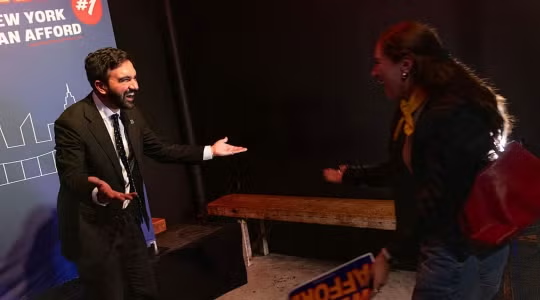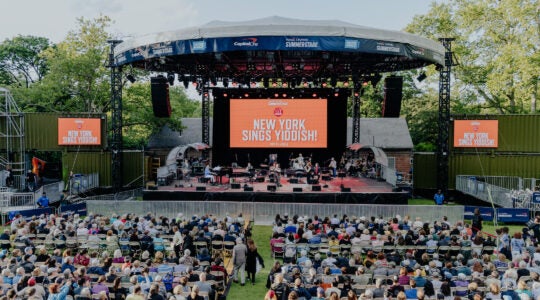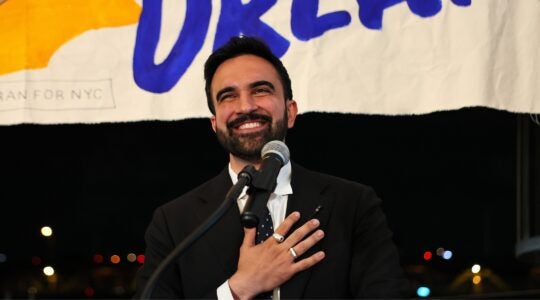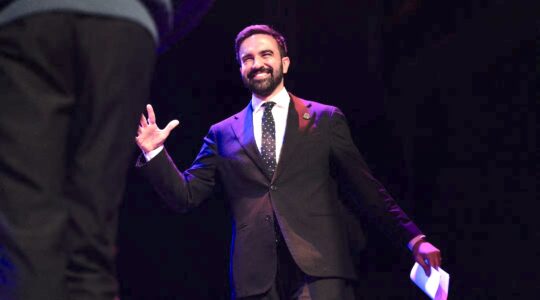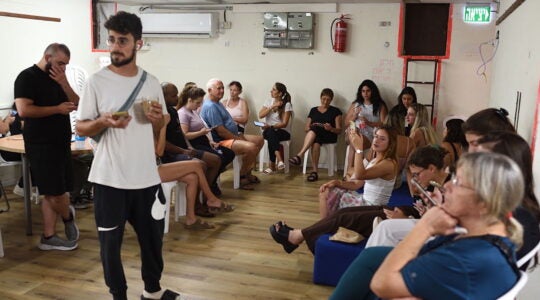A crowdsourcing project launched by the U.S. Holocaust Memorial Museum in Washington has provided a sharper picture of what Americans knew about the Holocaust as it was happening and how that knowledge shaped their response.
The answer to the first part of that question is “quite a lot,” JoAnna Wasserman, the museum’s education initiatives manager, said during a recent panel discussion in New York. Anyone reading the Jewish press in those days “knew what was happening in real time, while it was more masked in The New York Times,” said Rebecca Kobrin, another member of the panel and a professor of American-Jewish history at Columbia University. Newspapers outside of New York covered events in Europe quite frequently, although not necessarily on the front page.
The answer to the second part of the question — how Americans responded — is both sad and uplifting. Civic organizations, religious groups and political clubs sent petitions to the State Department demanding action on behalf of Germany’s Jews, Wasserman said, while others organized boycotts of German goods and marched through the streets of New York. A rally against fascism drew tens of thousands of protesters to Madison Square Garden. But polls conducted in 1939, one by Fortune magazine, showed that while the vast majority of Americans opposed Germany’s treatment of Jews, only a tiny minority favored allowing more Jewish exiles to enter the United States.
Put another way, articles at the time revealed an enormous gap between the public’s sympathy for the Jews and how far it was willing to go to help them, Wasserman said.
The panel discussion, held May 17 at Hunter College’s Kaye Playhouse, carried the same title as a new exhibit at the museum, “Americans and the Holocaust,” but added a special emphasis on what New Yorkers knew at the time. Similar events have taken place in Baltimore, Los Angeles, Phoenix and South Florida, each examining not only what Americans knew and did, but how local residents fit into the picture.
Many of the details have come to light through research conducted by “what we call citizen historians,” Wasserman told The Jewish Week in a phone interview after the New York discussion. Those are students, teachers, librarians and history buffs throughout the country who joined the museum’s crowd-sourcing project, History Unfolded, and researched how their local papers covered the Holocaust.
Nearly 3,000 Americans submitted more than 17,000 articles to the project as of last week, said Eric Schmalz, the museum’s citizen history community manager. Even more impressive is that their research involved not only searching the online archives of local papers, but the physical act of visiting local libraries and scrolling through articles on microfilm.
“Teachers have taken a particular interest [in the project] because it encourages their students to do primary-source research,” rather than just go to the Internet, Wasserman said. “It’s really hands-on.” New York-area schools that have participated in History Unfolded include the Bronx High School of Science, Grace Church High School in Manhattan, Beth Jacob of Borough Park and Plainview-Old Bethpage Middle School on Long Island.
Those efforts are reflected in a large, interactive map at the museum that allows visitors to the exhibit to touch their own state and see Holocaust-related articles that ran in their local press during the 1930s and ’40s. Visitors can also see the front-pages of local papers for a glimpse of how other stories of the era were competing for attention.
“We’re really trying to paint a comprehensive picture — a panorama — of what America was like in the 1930s and ’40s to understand the different pressures, fears and motivations for not just our leaders,” but “average American citizens,” Wasserman said at the recent panel discussion. The point, she added, was to understand how the tenor of the times shaped their response to the Holocaust.
Wasserman, for instance, described American society at the time as deeply racist and segregated, by law and by custom, and said that the influx of immigrants in the early part of the century had created a huge backlash against new arrivals. She also emphasized the cloud cast by the Great Depression as Americans struggled to find jobs, feed their children and keep a roof over their heads.
The Depression also created despair in New York, the population of which had grown from 3.5 million in 1900 to 7 million in 1930, Kobrin said. But along with the insecurity came “great hope,” she added, pointing to the construction of the Chrysler Building in the late ’20s, the Empire State Building in the early ’30s, and the election of Mayor Fiorella LaGuardia, a populist reformer, in 1933. “In many ways,” she said, as the son of Italian immigrants — one Catholic and one Jewish —he was a mayor who “encapsulated the notion of New York being an immigrant city.”
At the same time, Wasserman said, the American press began noticing Hitler’s rise in Europe, but, in many cases, “reporters didn’t know what to make of him.” Some publications treated him as a clown-like figure or as a passing phenomenon, while others took him more seriously. One reporter in the latter category was Dorothy Thompson, a Berlin-based pioneering female journalist who interviewed Hitler in 1932 and “sounded the alarm,” according to Ralph Blumenthal, the discussion’s moderator and a former reporter with The New York Times.
While steering the conversation, Blumenthal also focused on the role of The Times, which has been assailed for failing to give the Holocaust anywhere near the attention it deserved. Quoting a 2001 article by Max Frankel, the paper’s former executive editor, he said, “Only six times in six years did the Times’ front page mention Jews as Hitler’s unique target for total annihilation. Only once was their fate the subject of a lead editorial.” Of 23,000 front-page stories published between 1939 and 1945, about 11,500 concerned World War II and only 26 were about the Holocaust.
The Times has since apologized for that failure, publishing a statement in 1996 acknowledging that critics were right in accusing the paper of “grossly underplaying the Holocaust while it was taking place.”
Perhaps even more damning is that The Times’ failure “was not an error of omission,” Blumenthal said. “It was a conscious policy adopted by the nominally Jewish publisher” who feared that pleading the case for Europe’s Jews “would have placed the paper in jeopardy. … They made that decision calculatedly so as not to appear to be a Jewish publisher.”
“It hurts me as a Times reporter to recite this history,” Blumenthal told the audience. He didn’t say so publicly, but it also may have hurt him as the son of two Jewish parents who left Germany in 1929 and as the nephew of a man who died in either Bergen-Belsen, a concentration camp in Germany, or Majdanek, an extermination camp in Poland. The former Times reporter recounted some of that history during the panel discussion, saying that his family’s experience “gives poignancy” to his participation, and wrote about it extensively in a 2016 article for The Times, “In Berlin, Unraveling a Family Mystery.”
In a phone interview last week, Blumenthal told The Jewish Week that, like the American children of many Holocaust refugees, during the Holocaust and for many years after, he grew up hearing stories about his uncle – his mother’s brother – “but nothing of substance.” Parents “had their own grief,” he said, “but they never inflicted it on their children,” wanting to protect them from “the harsh realities of life. Even the term Holocaust didn’t emerge until after the war.”
While families knew that horrible things were happening in Europe, Blumenthal said, few could imagine “the magnitude of the disaster.” It wasn’t until 1942 when Americans learned about German plans for a “Final Solution” through a cable received by Rabbi Stephen Wise, president of the World Jewish Congress. But even then, Wasserman said during the panel discussion, the idea that all European Jews would be exterminated was far-fetched to most Americans.
The New York Jewish Week brings you the stories behind the headlines, keeping you connected to Jewish life in New York. Help sustain the reporting you trust by donating today.
